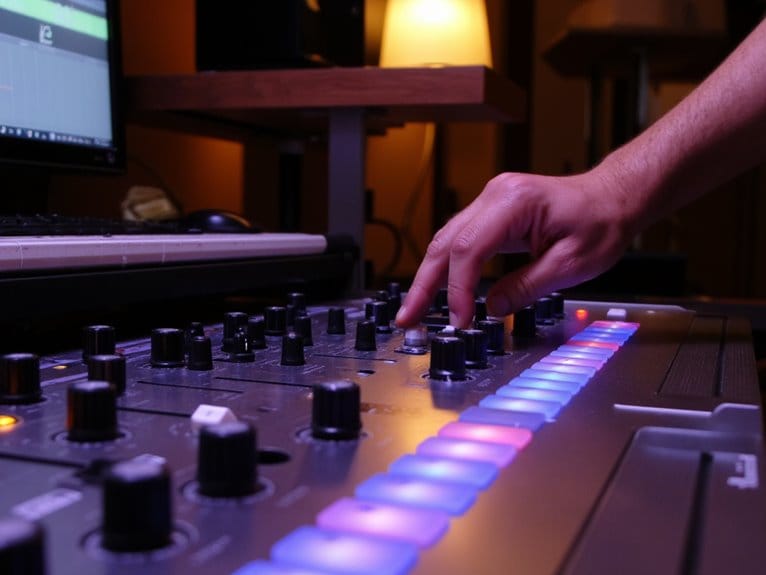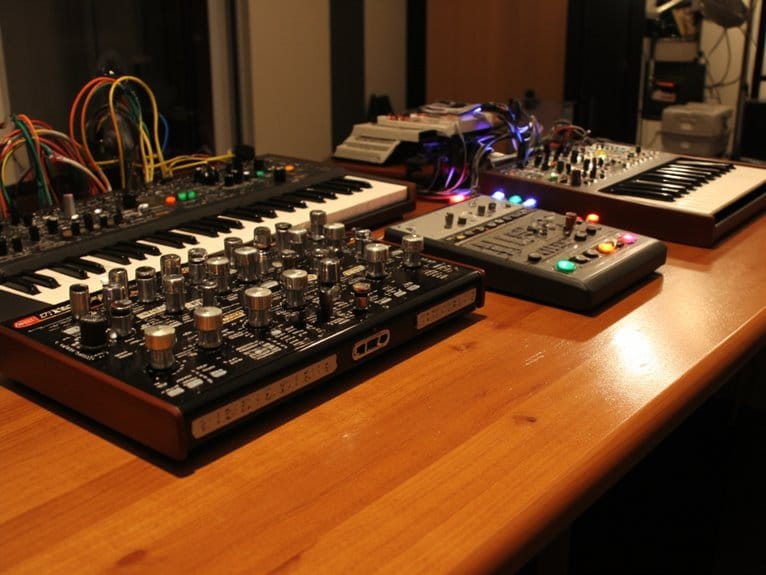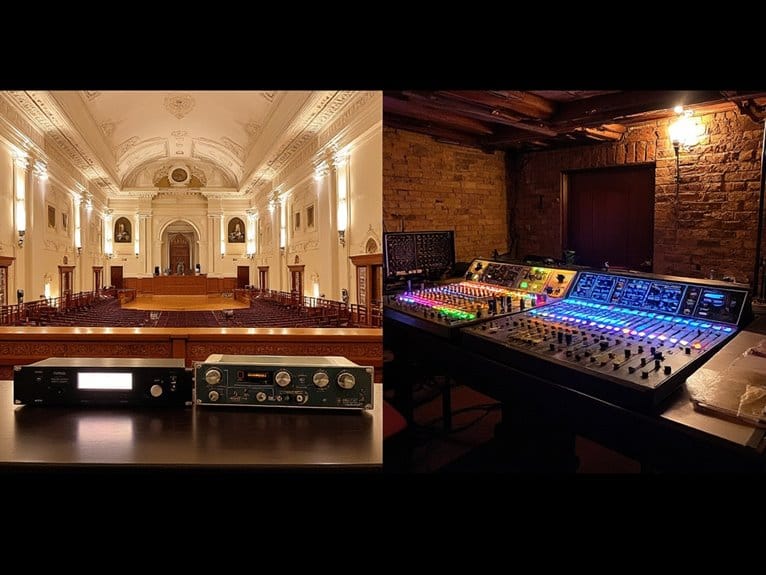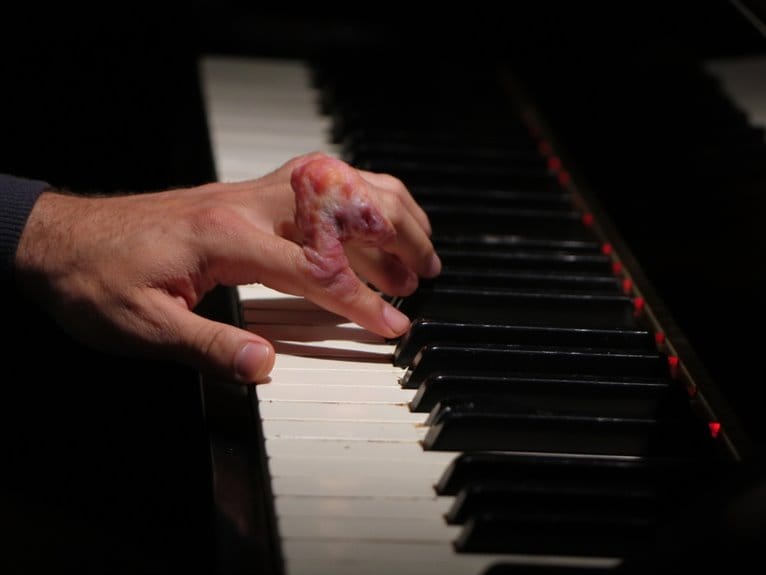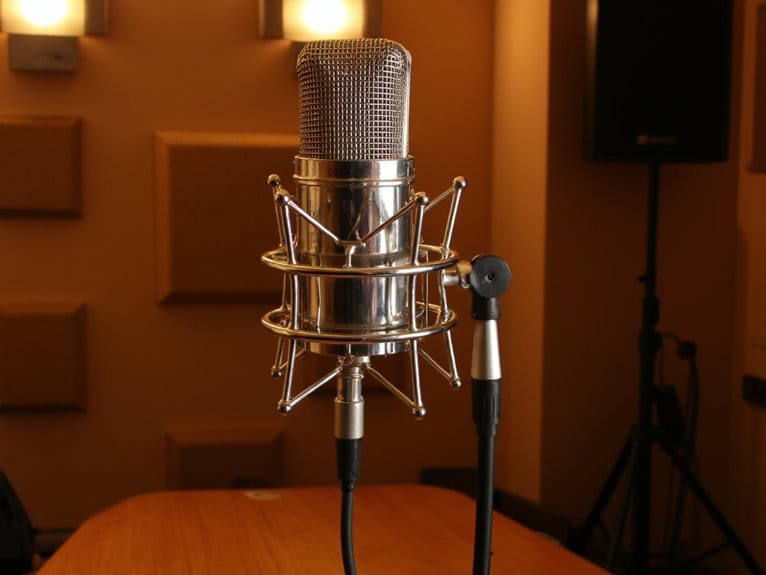Understanding MIDI Controller Mapping and Customization
MIDI controller mapping transforms your hardware knobs, faders, and buttons into precise software parameter controls through assignment processes that link physical movements to digital functions. You’ll choose from mapping modes like Toggle, Absolute, and Relative depending on your control needs, then enter mapping mode, select parameters, and move physical controls to establish connections. Modern controllers support velocity-sensitive keys, continuous parameters, and custom range adjustments that adapt to your playing style, while advanced features like takeover mode prevent parameter jumps between presets. Understanding these fundamentals opens doors to sophisticated workflow customization techniques.
We are supported by our audience. When you purchase through links on our site, we may earn an affiliate commission, at no extra cost for you. Learn more.
Notable Insights
- MIDI controller mapping involves assigning physical controls like knobs, faders, and buttons to specific software parameters through assignment processes.
- Different mapping modes include Toggle, Absolute, Set, and Relative, each optimized for controlling specific types of parameters and hardware.
- Custom mapping allows reassignment of default controls with range adjustments, scaling options, and velocity sensitivity for personalized workflows.
- Takeover mode Pickup prevents parameter jumps when switching presets, while proper hardware protocol understanding avoids mapping conflicts.
- Modern MIDI Remote protocols enable seamless DAW integration with custom labeling, User Maps, and multi-channel performance capabilities.
MIDI Controller Fundamentals and Message Types
While MIDI technology might seem intimidating at first glance, understanding its fundamental message structure is like learning the grammar of a universal musical language that’s been connecting instruments, computers, and controllers for over four decades.
MIDI communication protocols operate through distinct message categories that handle everything from musical performance to device synchronization. Channel Voice Messages carry your actual musical data—Note On, Note Off, Control Change, and Program Change commands that make things happen when you press keys or turn knobs. Beyond musical applications, MIDI has expanded into non-musical contexts like audio mixing console automation.
System Real Time Messages keep devices synchronized with timing clocks and transport controls, while System Exclusive Messages allow manufacturers to implement custom features. These MIDI message types work together seamlessly, creating the standardized framework that makes controller mapping possible across different brands and platforms. Modern controllers feature velocity-sensitive keys that respond dynamically to playing intensity, enhancing musical expression through these MIDI command structures. Many budget MIDI controllers now include phantom power support for connecting professional condenser microphones directly to the device. Professional audio equipment often includes UHF wireless technology for reliable signal transmission without interference from other devices. The original MIDI specification used five-pin DIN connectors for hardware connections, though modern controllers predominantly utilize USB and wireless connectivity options.
Mapping Modes and Assignment Processes
How do you transform those fundamental MIDI messages into meaningful control over your software parameters? You’ll choose from several mapping modes, each offering distinct mapping mode advantages depending on your hardware and workflow needs.
| Mode | Best For |
|---|---|
| Toggle | Buttons (0=Off, >64=On) |
| Absolute | Knobs and sliders |
| Set | Encoders requiring precision |
| Relative | Continuous adjustments |
The assignment process involves entering mapping mode, selecting your target parameter, moving the physical control, then validating the connection appears in your software’s mapping browser. While this seems straightforward, assignment mode challenges emerge when controllers send unexpected protocols or require specific trigger configurations. I’ve found that understanding whether your hardware sends Toggle or Set values prevents frustrating mapping conflicts that can derail studio sessions.
To prevent parameter jumps when switching between presets or templates, enable Takeover mode Pickup which ensures smooth transitions as you adjust physical controls.
Hardware Controls and Software Parameter Types
Once you’ve mastered the assignment process, the real magic happens when you understand how different hardware controls naturally align with specific software parameter types.
Different controller types excel at specific functions, and honestly, matching them correctly makes everything click into place.
Finding the right controller-to-function pairing is when MIDI control transforms from frustrating puzzle to intuitive musical extension.
Keyboards with their velocity-sensitive keys naturally handle note data including pitch, velocity, and aftertouch, while fader controllers shine when manipulating continuous parameters like volume and pan positions.
Drum pads work perfectly for triggering samples and percussion sounds, though I’ve found their pressure sensitivity varies considerably between manufacturers.
The parameter characteristics you’re controlling should dictate your hardware choice, since pitch wheels handle modulation smoothly, while buttons excel at program changes and switching functions during live performances.
Many digital pianos feature Bluetooth MIDI connectivity that allows seamless integration with software applications and enhances practice sessions with various music programs and apps.
Customization Techniques and Range Adjustments
Setting up your MIDI controller’s default mappings gets you started, but diving into customization techniques transforms your hardware into a precision instrument tailored specifically for your workflow. Custom mapping techniques let you reassign any knob, fader, or button to control whatever parameter matters most in your productions, while range adjustments guarantee those controls behave exactly how you need them to.
| Parameter Type | Range Adjustment | Creative Application |
|---|---|---|
| Velocity Sensitivity | Custom curves, 0-127 scaling | Dynamic expression control |
| Filter Cutoff | Inverted or limited ranges | Smooth sweeps, dramatic drops |
| Volume/Pan | Scaled output bounds | Subtle mixing, wide stereo effects |
| Aftertouch Mapping | Pressure-to-modulation scaling | Vibrato depth, effect intensity |
These adjustments accommodate your unique playing style, whether you prefer light touches or aggressive control movements.
Workflow Integration and Performance Applications
While customization gets your controller dialed in perfectly, the real magic happens when you seamlessly integrate that hardware into your daily production workflow and live performance setup.
Modern MIDI Remote protocols offer specialized DAW communication that goes far beyond basic Generic Remote mapping, providing direct control over transport functions, instrument plugins, and mix console parameters with features like soft take-over preventing jarring parameter jumps.
For workflow enhancement, you’ll want to create multiple User Maps that let you switch between production and mixing templates instantly, while custom labeling keeps everything organized during those late-night studio sessions.
The performance flexibility really shines when controlling up to 16 MIDI channels simultaneously, enabling seamless switching between virtual instruments and external hardware devices.
Frequently Asked Questions
Can I Use Multiple MIDI Controllers Simultaneously With the Same Software?
Yes, you can use multiple MIDI controllers simultaneously with most DAWs. Verify MIDI controller compatibility by assigning unique channels and enable advanced settings. Monitor for software performance issues when running multiple devices to avoid latency problems.
What Happens When I Accidentally Map the Same Parameter Twice?
When you accidentally map the same parameter twice, you’ll experience MIDI parameter conflicts where the second mapping overrides the first, creating erratic behavior. For mapping troubleshooting, check your controller assignments and remove duplicate bindings.
How Do I Backup and Restore My Custom MIDI Mappings?
You’ll need effective backup strategies for your custom mapping techniques. Copy your .tsi or configuration files to external storage, then use your software’s import function to restore them after reinstallation or system changes.
Why Does My Controller Sometimes Send Duplicate or Ghost MIDI Messages?
Your controller’s sending duplicate messages due to hardware sensitivity issues, poor connections, or software conflicts. Fix this through MIDI message filtering in your DAW, controller sensitivity adjustments, ghost note solutions, and MIDI jitter reduction techniques.
Can I Map Controllers to Parameters That Aren’t Currently Visible on Screen?
You can absolutely map controllers to off-screen parameters through your DAW’s parameter browser or mapping assistant. This hidden parameter mapping technique enables controller performance optimization by accessing internal controls that lack visible GUI representation.
On a final note
You’ve now got the essential knowledge to transform your MIDI controller from a basic input device into a personalized command center that matches your creative workflow. Whether you’re tweaking knob curves, assigning complex macros, or building custom templates, remember that effective mapping isn’t about using every available control—it’s about creating intuitive connections between your hands and your sound. Start simple, experiment freely, and let your music guide the customization process.

